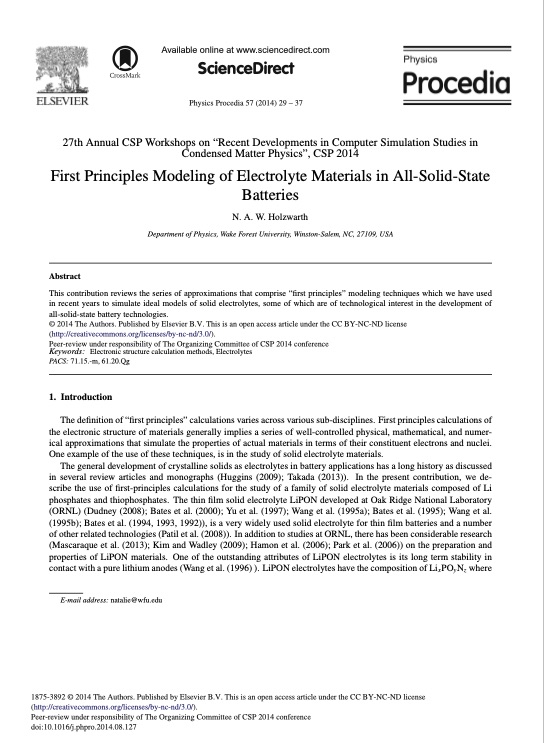
PDF Publication Title:
Text from PDF Page: 001
Available online at www.sciencedirect.com ScienceDirect Physics Procedia 57 (2014) 29 – 37 27th Annual CSP Workshops on “Recent Developments in Computer Simulation Studies in Condensed Matter Physics”, CSP 2014 First Principles Modeling of Electrolyte Materials in All-Solid-State Abstract Batteries N. A. W. Holzwarth Department of Physics, Wake Forest University, Winston-Salem, NC, 27109, USA This contribution reviews the series of approximations that comprise “first principles” modeling techniques which we have used in recent years to simulate ideal models of solid electrolytes, some of which are of technological interest in the development of all-solid-state battery technologies. ©⃝c 201144TThheeAAutuhtohrosr.sP.uPbulibshliesdhebdy bEylseEvliservBie.rVB. T.Vh.is is an open access article under the CC BY-NC-ND license (Phetetpr:-/r/ecvreieawtivuecnodmermroensps.onrgs/ilbicileintyseos/fbtyh-encO-nrgda/3n.i0z/i)n. g Committee of CSP 2014 conference. Peer-review under responsibility of The Organizing Committee of CSP 2014 conference Keywords: Electronicstructurecalculationmethods,Electrolytes PACS: 71.15.-m, 61.20.Qg 1. Introduction The definition of “first principles” calculations varies across various sub-disciplines. First principles calculations of the electronic structure of materials generally implies a series of well-controlled physical, mathematical, and numer- ical approximations that simulate the properties of actual materials in terms of their constituent electrons and nuclei. One example of the use of these techniques, is in the study of solid electrolyte materials. The general development of crystalline solids as electrolytes in battery applications has a long history as discussed in several review articles and monographs (Huggins (2009); Takada (2013)). In the present contribution, we de- scribe the use of first-principles calculations for the study of a family of solid electrolyte materials composed of Li phosphates and thiophosphates. The thin film solid electrolyte LiPON developed at Oak Ridge National Laboratory (ORNL) (Dudney (2008); Bates et al. (2000); Yu et al. (1997); Wang et al. (1995a); Bates et al. (1995); Wang et al. (1995b); Bates et al. (1994, 1993, 1992)), is a very widely used solid electrolyte for thin film batteries and a number of other related technologies (Patil et al. (2008)). In addition to studies at ORNL, there has been considerable research (Mascaraque et al. (2013); Kim and Wadley (2009); Hamon et al. (2006); Park et al. (2006)) on the preparation and properties of LiPON materials. One of the outstanding attributes of LiPON electrolytes is its long term stability in contact with a pure lithium anodes (Wang et al. (1996) ). LiPON electrolytes have the composition of LixPOyNz where E-mail address: natalie@wfu.edu 1875-3892 © 2014 The Authors. Published by Elsevier B.V. This is an open access article under the CC BY-NC-ND license (http://creativecommons.org/licenses/by-nc-nd/3.0/). Peer-review under responsibility of The Organizing Committee of CSP 2014 conference doi:10.1016/j.phpro.2014.08.127PDF Image | First Principles Modeling of Electrolyte Materials in All-Solid-State Batteries

PDF Search Title:
First Principles Modeling of Electrolyte Materials in All-Solid-State BatteriesOriginal File Name Searched:
1-s2-0-S1875389214002727-main.pdfDIY PDF Search: Google It | Yahoo | Bing
Sulfur Deposition on Carbon Nanofibers using Supercritical CO2 Sulfur Deposition on Carbon Nanofibers using Supercritical CO2. Gamma sulfur also known as mother of pearl sulfur and nacreous sulfur... More Info
CO2 Organic Rankine Cycle Experimenter Platform The supercritical CO2 phase change system is both a heat pump and organic rankine cycle which can be used for those purposes and as a supercritical extractor for advanced subcritical and supercritical extraction technology. Uses include producing nanoparticles, precious metal CO2 extraction, lithium battery recycling, and other applications... More Info
| CONTACT TEL: 608-238-6001 Email: greg@infinityturbine.com | RSS | AMP |